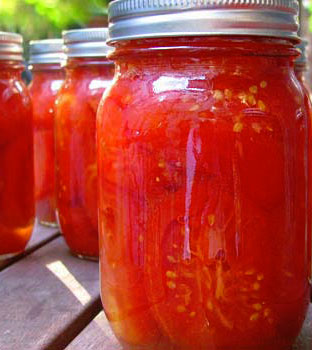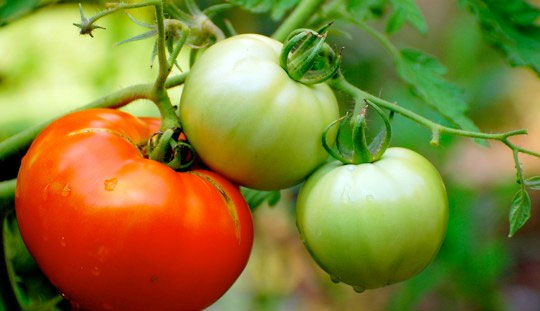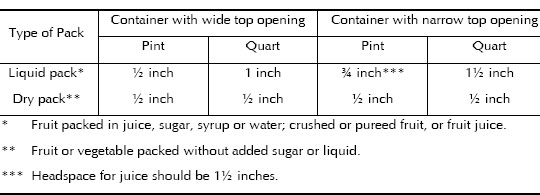Beauty Of Tomatoes: Enjoy Them Now, Preserve Extras For Later
July 8, 2011
The beauty of tomatoes this time of year is that they are red, and juicy, and that there are so many of them. If you grow your own, you probably think you have more than you can ever use. If you buy them at the local farmer’s market, you have an endless variety to choose from.
No matter how many tomatoes you have this summer, there are many different ways to use them. Summer’s tomatoes are delightful right off the backyard grill, or tossed with vinegar, oil and basil, or stirred into a primavera over pasta, or simply sliced and served cold.
You may want to consider preserving some of the summer’s bounty. Tomatoes retain many of their best qualities when preserved for use when the garden is just a memory.
Whether you freeze, can, or dehydrate tomatoes, your success will depend on the quality and freshness of the vegetable. It is best to process tomatoes as soon as possible after harvesting. Always discard underripe or too-mature tomatoes.
Dried tomatoes are delicious when rehydrated and added to pasta dishes, salads, or stirfry. They can be stored in any food-safe container that protects them from air and moisture. Home canning jars make excellent storage containers because they can be kept tightly closed, and they provide the added convenience of a see-through container. Dried tomatoes don’t have to be refrigerated if they are properly contained. Sun-dried tomatoes can add distinctive flavors to dishes.
 Frozen tomatoes retain their flavor, but lose some of their texture in the freezing process. They are an excellent choice to use for sauces or in stews and casseroles. Wash, core, and cut tomatoes, then cook them until soft. Cool, package, and freeze for later use. Canning tomatoes is one of the best ways to preserve their flavor and nutritional value. Select tomato varieties with thick flesh and fewer seeds. Use only quality tomatoes with no cracks, fungus growths, bruises or decayed spots.
Frozen tomatoes retain their flavor, but lose some of their texture in the freezing process. They are an excellent choice to use for sauces or in stews and casseroles. Wash, core, and cut tomatoes, then cook them until soft. Cool, package, and freeze for later use. Canning tomatoes is one of the best ways to preserve their flavor and nutritional value. Select tomato varieties with thick flesh and fewer seeds. Use only quality tomatoes with no cracks, fungus growths, bruises or decayed spots.
The canning process requires several steps. Washed tomatoes are first scalded, then cored, peeled and left whole, or cut into pieces. They are then boiled in just enough water to cover tomatoes, five to ten minutes. Pack into heated jars, adding citrus acid and seal with a vacuum cap. The canned tomatoes must then be processed in a boiling-water canner or pressure canner. This destroys micro-organisms that can spoil the tomatoes.
Citric acid is added to tomato recipes developed for safe processing in a boiling water canner. The citric acid is added to ensure the proper ph level for processing.
Many home canners “put up” barbecue sauce, salsa, spaghetti sauce, and tangy ketchup, to name just a few preservable foods using tomatoes.
Today, there are more than 500 varieties of tomatoes and other fruits and vegetables from all over the world available in the United States. Each one offers its own distinctive flavor, texture, and nutritional value. With all these options, preserving the fresh fruits and vegetables of summer is easy, and best of all, it captures the essence of the season for months to come.
Selecting, Preparing, and Canning Tomatoes
Select only disease-free, preferably vineripened, firm fruit for canning. Caution: Do not can tomatoes from dead or frostkilled vines. Green tomatoes are more acidic than ripened fruit and can be canned safely with any of the following recommendations.
Acidification: To ensure safe acidity in whole, crushed, or juiced tomatoes, add two tablespoons of bottled lemon juice or ½ teaspoon of citric acid per quart of tomatoes. For pints, use one tablespoon bottled lemon juice or ¼ teaspoon citric acid. Acid can be added directly to the jars before filling with product. Add sugar to offset acid taste, if desired. Four tablespoons of a 5% acidity vinegar per quart may be used instead of lemon juice or citric acid. However, vinegar may cause undesirable flavor changes.
Recommendation: Use of a pressure canner will result in higher quality and more nutritious canned tomato products. If your pressure canner cannot be operated above 15 PSI, select a process time at a lower pressure.
Sun-Dried Tomatoes
Wash and stem ripened tomatoes. Slice horizontally, about ¼-inch thick. Salt on both sides and let sit for 30 minutes. Rinse. Lay on foil-covered baking sheets. Cover lightly with cheesecloth. Place in sun for several hours, turning occasionally until desired dryness is achieved. Store in jars in a cool pantry.
Intensely flavorful, dried tomatoes add snap to salads and breads. Also can be moistened to make sandwiches.
Freezing Tomatoes
Select firm, ripe tomatoes with deep red color.
Raw
Wash and dip in boiling water for 30 seconds to loosen skins. Core and peel. Freeze whole or in pieces. Pack into containers, leaving 1-inch headspace. Seal and freeze. Use only for cooking or seasoning since tomatoes will not be solid when thawed.
Juice
Wash, sort and trim firm, vine-ripened tomatoes. Cut in quarters or eights. Simmer 5 to 10 minutes. Press through a sieve. If desired, season with 1 teaspoon salt to each quart of juice. Pour into containers, leaving headspace according to Table 1 (bottom of page). Seal and freeze.
Stewed
Remove stem ends, peel and quarter ripe tomatoes. Cover and cook until tender (10 to 20 minutes). Place pan containing tomatoes in cold water to cool. Pack into containers, leaving headspace according to Table 1 (bottom of page). Seal and freeze.
Table 1. Headspace to allow between packed food and closure.
For more information contact Dorothy C. Lee, Escambia County Extension Agent, dclee@ufl.edu , or (850) 475-5230.
Comments
3 Responses to “Beauty Of Tomatoes: Enjoy Them Now, Preserve Extras For Later”






T,
Blossom end rot is usually caused by a calcium deficiency. Some say that overwatering can do it too, but it’s never happened to me. Tomato Rot-Stop is a natural product that can treat it. More economical (but less “organic”) options are out available too.
As for non-hybrid varieties, I’d like to know too. Ever’man Natural Food sells non-hybrid, heirloom tomatoes in the produce department. Unfortunately, they sell only the fruits, not the plants.
Would like to hear if anyone is successfully growing any non-hybrid heirloom varieties and any garden tricks to gettting consistent non-bloomrot pretty tomatos.
All I can say is please follow USDA home canning methods. My granny always used what’s know as the “open kettle” method: Get the food hot, jars hot, boil the rings and lids, then lid the jars and hope the seal sets. This is not at all safe.
There is no substitution for adequate heat. The boiling water bath method is recommended by the USDA. Unfortunately, it is much more time consuming. It greatly reduces your chances of contracting E. coli, botulism, etc.
Learn more: http://www.uga.edu/nchfp/publications/uga/using_bw_canners.html